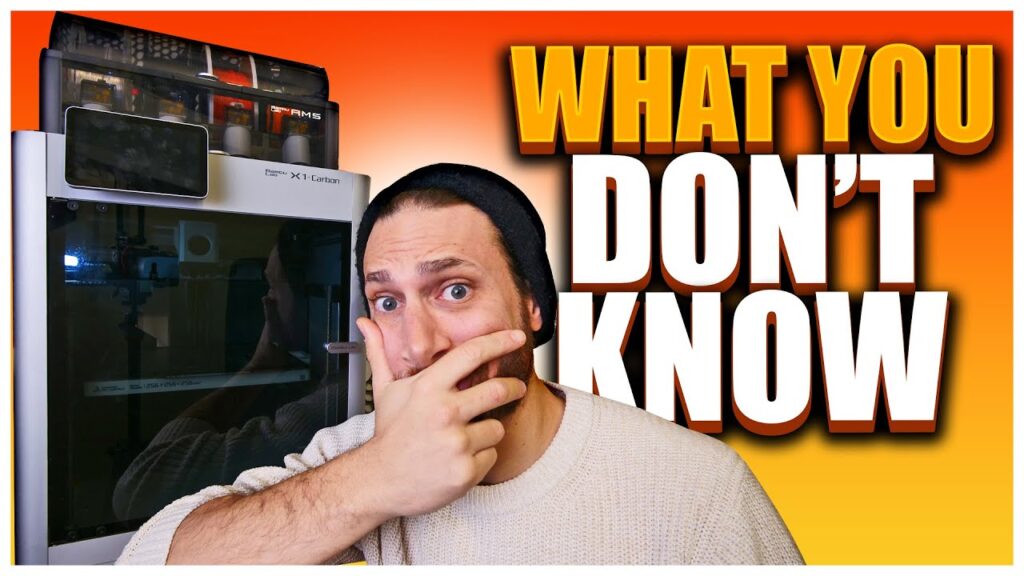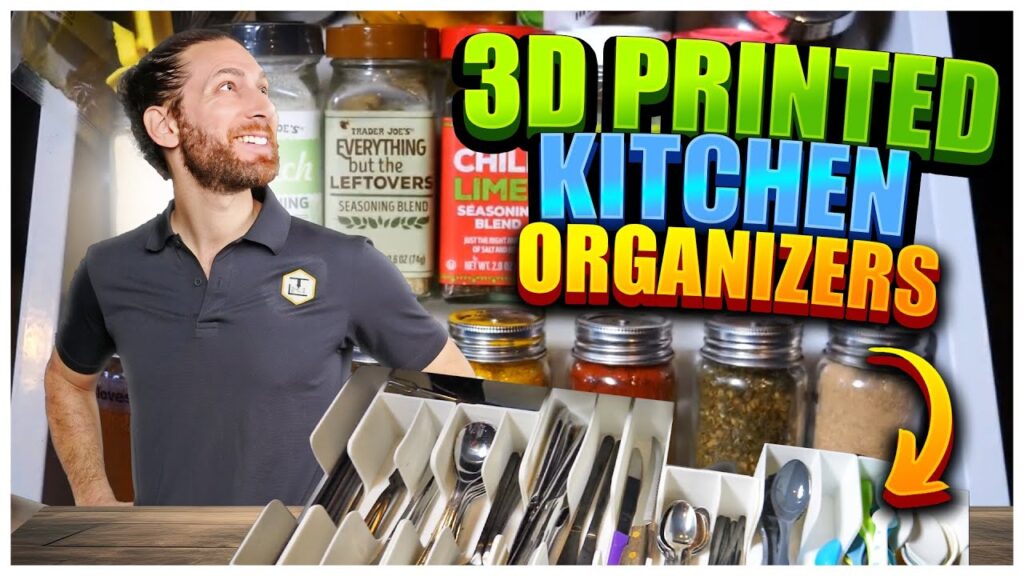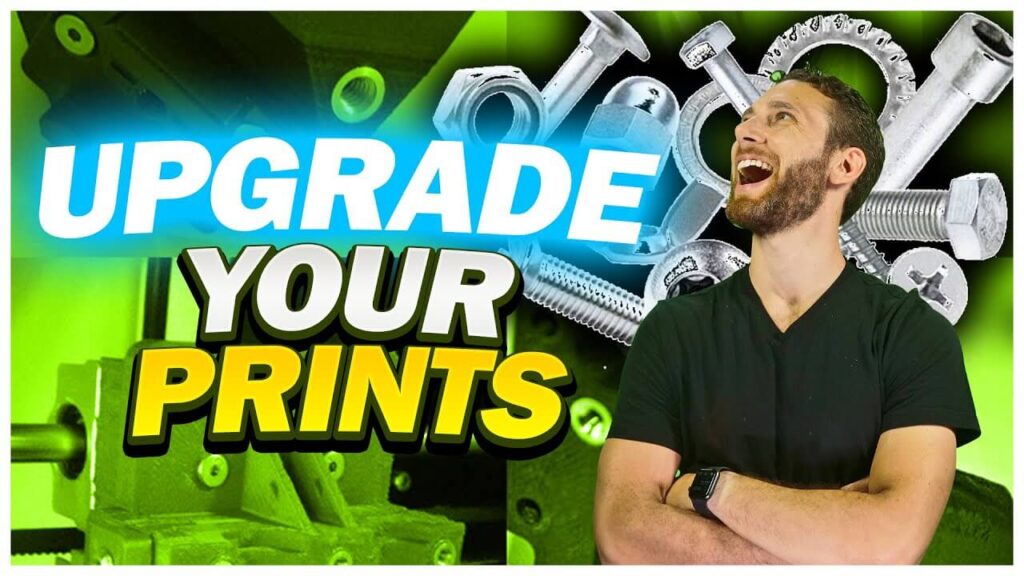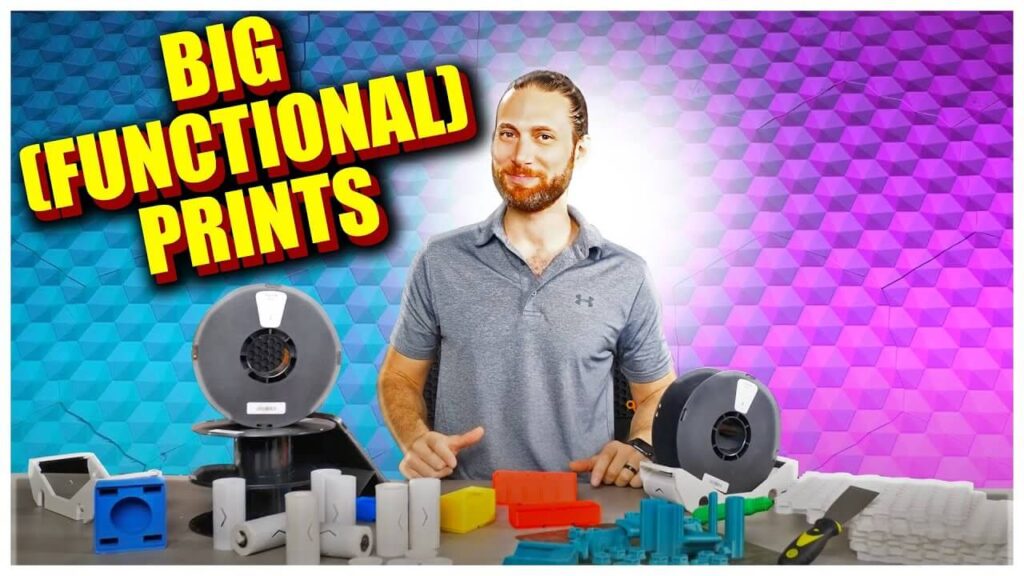In this article, we’re going to explore the 8 most popular “advanced” filament types YOU can print with an at-home 3D printer to understand their differences, their applications, and why YOU might want to check them out.
Let’s dive in.
Background – Advanced 3D Printing Filaments
Previously, I put out a list of the top 5 most common 3D printer filaments you need to know about, and what types of applications are best suited for each type of filament.
You guys loved that video, and the only criticisms I received were that people were hoping I would go into the more “advanced,” engineering-grade filaments like Nylon, Polycarbonate, and carbon composites.
These types of filaments are becoming more and more popular, due to the increased popularity of enclosed consumer-grade printers and hardened extruders and nozzles that are actually capable of printing these types of materials.
With that said, at the outset of this video, I admittedly had pretty limited experience with most of these types of filaments. And so I set out on a journey, printing all different types of parts with different types of filaments, researching the differences, reading various technical data sheets, and consulting directly with experts.
Shout out to my friends over at Kexcelled, a leader in creating crazy composite materials like Carbon Fiber Peek and more, for actually putting their lead engineers on a call with me and filling in my gaps in knowledge.
So, without further adieu, here it is: the 8 “advanced” filament types YOU need to know about:
Nylon

To top this list off, let’s start with plain Nylon.
Generally speaking, Nylon is an incredibly durable material. It features higher heat resistance than most commodity plastics such as ABS or PETG, and really excels in toughness (aka durability) and strength, particularly inter-layer adhesion. Additionally, it offers more ductility than other plastics, meaning it has “give” and “flex” like PETG, particularly in thin parts. This is a large contributor to it’s toughness.
Nylon also exhibits great chemical resistance, making it a great choice when your part will be exposed to oils or solvents. Additionally, Nylon is quite affordable when compared to other heat-resistant plastics such as PEEK.
The downsides, however, are that it can be tricky to print. First, all nylons are highly hygroscopic, and need to be printed directly from a filament dryer for best results. Second, this material is highly prone to warping, so an enclosure is an absolute must.
By the way, in 3D printing, there are two different types of Nylons that are commonly used: PA-6 and PA-12. In case you’re wondering, the names indicate the number of carbon atoms in it’s repeating units, which, in turn, dictate different behavioral properties of the material.

PA-12, for example, has a lower moisture absorption rate, making it more stable in various environmental conditions, both during and after printing, as well as higher flexibility. PA-6, conversely, has higher strength and stiffness, but is more easily affected by moisture, and a higher melting point, making it trickier to print. This is why, when it comes to “plain” nylons without carbon fiber, PA-12 is usually more popular for 3D printing.
OK, so that’s a list of characteristics, but I know that that’s probably confusing and not too helpful, so throughout this guide, as with my previous one, I’m going to give you a list of examples and applications that Nylon is best suited for.
In the case of Nylon, these include anything that needs to withstand high heat, applications where the part will be repeatedly abused, bumped, vibrated, or impacted, and applications where you actually WANT high ductility. The list of specific examples includes: plastic gears, automotive parts, flexible hinges, workshop tools, gaskets, and more.
If you’ve ever used Nylon in the past, I’d love to know in the comments below, what did you print with it?
Polycarbonate
To continue our exploration of advanced 3D printing materials, let’s dive into PolyCarbonate, often abbreviated as PC.
Recognized for its exceptional clarity and robustness, PC stands out as one of the toughest thermoplastics available.
When compared to standard plastics like ABS or PLA, PC, like Nylon, offers superior heat resistance, making it a prime choice for applications that demand high thermal stability.
Its strength is commendable, and its inter-layer adhesion in 3D prints is often dramatically superior, resulting in robust and cohesive parts.
One of the most distinguishing features of PC is its impressive impact resistance. In terms of rigidity vs. ductility, PC is somewhere between ABS and PLA on the “rigid” side, and Nylon on the “ductile side.”
So while it is still pretty rigid, and can therefore shatter, it is still able to absorb significant shocks without breaking. This resilience, combined with its high transparency, is why it’s frequently used in bulletproof glass and eyewear lenses – though obviously not 3D Printed ones. Additionally, while specialty filaments like PEEK might outperform PC in certain extreme conditions, PC remains a more budget-friendly option for many applications that require high performance but not the absolute peak. Ha, get it? PEEK?
However, 3D printing with PC isn’t for the faint of heart.
Similar to Nylons, PC is quite hygroscopic, which can impact print quality. Although its moisture absorption is generally lower than that of Nylons, it’s still advisable to store PC filaments in a dry environment and consider using a filament dryer while printing. Additionally, PC is notorious for its tendency to warp, especially in larger prints.
There ARE some PC blends, like the one made by Prusament or Kexcelled’s PCK7, which aim to combat this, but as I’ll say a few times throughout this video, a tiger doesn’t change it’s stripes, and even these easier-to-print blends are, at the end of the day, PC, and they’ll behave like it.
Therefore, using an enclosed printer and ensuring a heated bed is essential for optimal results – and even then, you might need to heat the chamber and/or use bed adhesion products to reduce warping.
When considering which applications are best suited for PC, think of scenarios demanding strength, clarity, and heat resistance.
Ideal use cases include projects with lighting elements, for example light housings, fixtures, or cases for electronics with LEDs. PC is also great for drone parts, containers that need to be clear, such as bins, buckets, or tanks for liquids… it’s even suitable for prototypes for functional testing under strenuous conditions. Its durability and clarity make it a favorite for many in the 3D printing community.
If you’ve had the opportunity to work with PolyCarbonate in your 3D printing endeavors, I’d love it if you shared your experience in the comments below. What creative applications have you discovered for this versatile material?
PLA-CF
Continuing our journey into the realm of specialized 3D printing materials, let’s discuss PLA-CF, which is essentially PolyLactic Acid (PLA) reinforced with Carbon Fiber.
At its core, PLA is a biodegradable thermoplastic derived from renewable resources like cornstarch or sugarcane. It’s a favorite among 3D printing enthusiasts due to its incredible strength and rigidity, combined with it’s extreme ease of printing and minimal warping.
Believe it or not, PLA is SO strong, Clough42 actually discovered that it is superior to PA-CF – which I don’t think anybody expected. However, when infused with carbon fibers, PLA undergoes a transformation that enhances some of its mechanical properties, while reducing others.
First, the addition of carbon fibers actually increases the stiffness and strength of PLA. Kind of.
You see, here, I need to go on a small tangent, because “increased strength” is something that’s touted on ALL of the carbon-fiber reinforced filaments on this list, but it’s a little bit misleading. Yes, depending on the quality of the filament and the printing conditions, you may achieve increased strength in the axial direction, and Some PLA-CF formulations use surface-treated CF, and as a result inter-layer adhesion isn’t impacted a lot, such as Kexcelled’s own PLA K6CF.

But generally speaking, because the carbon fibers are basically a contaminant, you will also generally experience decreased strength in between layers. This was corroborated not only by the experts at Kexcelled, but also by Stefan from CNC Kitchen, who has done more testing of more filaments’ strength than anyone in this community.

So when companies advertise the “strength” of carbon fiber filaments, they aren’t generally explaining this nuanced point. To wit, when I spoke with Kexcelled’s engineers, they flat out told me that because PLA is already so incredibly strong and rigid, they consider PLA-CF to be a bit of gimmick, who’s primary benefit is actually aesthetic.

This is not only because of the beautiful matte, textured finish, but also because, as with all of the carbon composites on this list, adding carbon fibers improves its dimensional stability by reducing warping and making parts come out much cleaner. Though, again, PLA doesn’t suffer from printability or warping..
Sure, adding carbon fibers can make this material “stronger” and more rigid in some specific senses, but it’s still PLA – not an “engineering grade” material – and so it will still retain the downsides of PLA, including absolutely zero tolerance for heat.
What’s more, carbon fibers can also make some of the bad characteristics of PLA, like brittleness, and make them worse. And while PLA-CF, and really all of the CF-composites on this list, print even better than they’re pure counterparts, they’re also all incredibly abrasive.
This means that whenever you print with ANY carbon composite filament, you’ll need to ensure that you print with a hardened steel or ruby nozzle, and ideally, that you have all-metal gears. Plus, you’re going to experience accelerated wear on any bowden tubes.
In terms of applications, PLA-CF is ideal for components that need a balance of strength and lightweight construction.
Think of drone frames, RC car components, and even lightweight tooling. I even like to use it for mounting brackets, so long as they don’t need to flex or take any impact. It’s also great for saving money on prototypes, because it will exhibit similar dimensional behavior to PA-CF, but costs considerably less.
For those who have ventured into printing with PLA-CF, how did you find the experience? And do you share the conclusion that this material is a bit of a gimmick? Please share your experience below!
PETG-CF
Continuing our exploration into carbon-fortified filaments, let’s next turn to PETG-CF.
At first, PETG-CF had me scratching my head.
I mean, practically the ONLY thing I like about PETG is that it is ductile and flexes, wouldn’t adding carbon fibers take away that one redeeming quality?
But as it turns out, these fibers elevate the inherent qualities of PET, adding increased stiffness, strength, and even heat-resistance to the material.
Whereas PETG is quite ductile, with a certain amount of flex and “give,” PETG-CF is considerably more rigid. The result is a filament that can take a considerable amount of abuse – even more than standard PETG in some cases.
Like PETG, this filament exhibits superior resistance to both ultraviolet light and chemicals.

PETG-CF is generally more affordable and much easier to print than other filaments with similar performance. And if all that weren’t enough, parts made of PETG-CF enjoy improved printability and dimensional accuracy.
Moreover, the carbon fibers grant the printed objects a unique matte and textured finish, which normally can’t be achieved with PETG. I don’t know about you, but I generally prefer just about everything I print to be Matte.
Really, there are only three major “downsides” or tradeoffs to PETG-CF. First, it requires abrasion-resistant hardware such as nozzles. Second, like all PETG, it’s hygroscopic – though nowhere near as much as, say, Nylon. Finally, despite all it’s impressive performance, it is still nowhere near as heat-resistant as Nylon, PC, or even ABS.
So where does that leave us in terms of applications?
Well, PETG-CF really stands out in scenarios demanding a balance between durability, cost, and lightweight design.
It’s an excellent choice for parts that may undergo moderate stress, such as custom enclosures, protective gear, or even certain robotics components. The material’s unique finish also lends a touch of sophistication to prototypes or end-use parts.
Like PLA-CF, it could also great for saving money on prototypes that will eventually be printed in a more expensive carbon composite material.
But above all else, PETG-CF shines at being easy to print, without a filament dryer or heated enclosure, and so the best applications are going to be if you need to be able to print some of the items in the PA-CF or ABS-CF sections, but don’t have the hardware or the budget to do it in those respective materials.
For those who have dabbled in printing with PETG-CF, what are your thoughts? Are you, too, converted into becoming a believer, or do you think that PETG-CF is just a second-rate option for people who can’t print or afford PA-CF? I’d love to hear your insights below!
PA-CF & PAHT-CF
Up next, let’s talk about probably the most popular carbon composite out there for 3D printing right now, Carbon Fiber Nylons, such as PA-CF or PAHT-CF.
These come in different flavors, ranging from PA-6-based versions to PA-12 versions, high heat versions and standard ones.
Like I mentioned in our discussion of standard PA-6 vs. PA-12, these have slightly different characteristics, often depending on the brand and application purchased, but they generally share the same over-arching differences when Carbon Fibers are added.
You’ll recall, from that earlier discussion, that we talked about Nylon’s high ductility and flexibility, and that it is ideal for situations where that ductility, rather than rigidity, are desired.
Adding Carbon Fibers to it, then, has a similar purpose as adding them to PETG. It allows you to enjoy the durability and heat resistance of Nylon, without the ductility.
In other words, if what you want is rigidity AND heat resistance, that’s where PA-CF or PAHT-CF make sense.
Here, again, there’s a give-and-take. Yes, adding carbon fibers does gain rigidity, but you lose some of that impact resistance, and therefore, durability.
This is because Carbon fiber parts can take more force before they deform, but once they do start to deform, they will fail catastrophically instead of simply deforming. This means that for any part where you wouldn’t want catastrophic failure, such as something holding weight, it would be better to use pure Nylon. Conversely, if you want something to be affixed in a very rigid way, without a millimeter of give, then you need CF Nylon.
I’ve also mentioned a few times how adding carbon fibers improves printability.
This is true of all of these materials compared to their plain counterparts, but in the case of nylon, it’s especially pronounced.
As I mentioned before, Nylon can be a real pain in the butt to print, and adding carbon fibers makes it significantly easier by reducing warping and improving dimensional accuracy.
In fact, if you are unable to print Nylon, even on your enclosed printer, you might just find that you CAN print PA-CF.

Even more interestingly, the addition of Carbon Fiber to Nylon can add 10-20 degrees celsius to eat’s heat resistance, making it truly the best consumer-grade alternative to something like PEEK.
As for specific use cases, I’ve used it for caster wheel mounts that need to be rigid yet durable, and it’s generally really good in applications around your workshop where you need rigidity under heat.
This may include mounting brackets for inside an enclosure, or tools that need to remain rigid even when used around, say, a heat gun, an open flame, or a soldering iron. Though, as Stefan from CNC Kitchen found out, it’s NOT good for printing Voron parts!
ABS-CF
So, we’ve made it through some of the more popular carbon fiber filaments – let’s talk about one that doesn’t get as much attention: ABS-CF.
Here, once again, a tiger doesn’t change it’s stripes: this is still ABS, with all the pro’s and cons of ABS, but here, once again, adding carbon actually makes it more printable. Which, if you’ve ever printed ABS, is a welcome addition.
We’ve already talked a lot about the differences between Carbon Fiber reinforced filaments and their plain counterparts, and you can basically sum it up as improving rigidity, axial strength, and printability at the expense of affordability and layer adhesion.
So let’s jump straight into WHY you might choose ABS-CF over any of the other Carbon Fiber composited on this list.
First of all, ABS, being a commodity plastic, is going to be significantly cheaper than something like Nylon – meaning that it’s carbon composite version will be, too.
Second, though PA-CF is fairly easy to print, ABS-CF is going to be even easier in most cases. It is far less hygroscopic than PET-CF or PA-CF, and warps much less than the latter, though it does still require an enclosure, unlike PET-CF.
What’s more, ABS, as a base plastic, is incredibly durable, and just an all-around great polymer, which explains why it is the obvious choice for most consumer goods, from toys, to tools, to electronics and really anything outside of disposable packaging.
Similarly, I’d say that ABS-CF is really a great “all around” compromise. It doesn’t excel at any one thing, but it nicely blends affordability, printability, durability, strength, moderate heat resistance, and rigidity.
In other words, if you have an enclosed printer, but don’t want to deal with PA-CF or it’s price, ABS-CF is a great option.
And like PA-CF and PET-CF, it’s great for things like automotive parts under moderate heat, tools, indoor brackets that need to be rigid, such as for camera equipment, robotic arms, really anything that needs a lot of rigidity.
Just note that unlike PET-CF, ABS-CF does not do well when exposed to ultraviolet light or chemicals!
Once again, if you’ve used ABS-CF, I’d love to know in the comments below what exactly you used it for, and whether or not you agree with my assessments.
ABS-GF
We’re almost done, but before we go, I want to mention one last advanced filament, and that’s ABS-GF, or Glass Fiber.
As the name suggests, this filament swaps Carbon Fibers out for Glass fibers, which are somewhat more economical, and have slightly different mechanical properties.
Whereas adding carbon can improve axial strength and rigidity, glass fibers can instead add tensile strength. Whereas carbon fibers improve heat and even electrical conductivity, aiding in heat dissipation, glass fibers don’t, meaning that they may even be preferable in environments involving electronics or electricity.
There are a lot of other nuanced differences in areas like abrasion, but ultimately, the main factor here is going to be price. If you can justify it, or if it’s for the final product, ABS-CF will be better, but ABS-GF is still great for adding a bit of tensile strength over standard ABS without breaking the bank, or just prototyping parts that will later be reprinted in ABS-CF.
Some examples include electronics housings, tool cases, tools, or handles, which take advantage of it’s enhanced tensile strength.
Conclusion
So there you have it, the top 8 advanced and high-performance filaments, as well as how to best take advantage of their individual strengths (pun intended).








